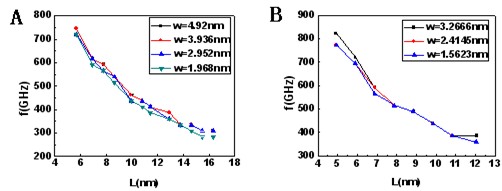| Materials Studio is one of the most famous softwares to do the simulation in material field. It is the simulation that can mostly guide the real experiment. Via Forcite/Dmol3/ CASTEP, we have discussed properties of various of nanostructures. |
Vibrational behavior of graphene nanoribbon-based nanoresonators |
We investigate the vibrational characteristics of graphene nanoribbon-based nanoresonators using molecular dynamics method based on Forcite module in Materials Studio.The simulation models of the graphene nanoribbons (GNRs) as doubly clamped beams are shown in Fig.1. The clamped edges are marked in red color. L is the beam length and defined as the distance between two clamped edges. W is the beam width and defined as the distance between two free edges. The vibrational behavior of the GNRs was calculated using the COMPASS forcefield in Forcite module at room temperature. The curves of intrinsic frequencies of the GNRs versus length (L) with different widths (W) are presented in Fig. 2. The numerical results reveal that the intrinsic frequency of GNR-based doubly clamped beams obviously decreases with the increase of beam length. However, it is not very sensitive to the chirality or the aspect ratio of beam.
Furthermore, the vibrational characteristics of gold-doped GNRs also have been simulated with the same methods as mentioned above. Two carbon atoms are replaced by one gold atom in our simulation models, which is schematically shown in Fig. 3(A) by the red circle. The real positions doped by gold are marked by numbers from 1 to 9. Two situations are considered. One is doped by two gold atoms and the other is doped by four gold atoms. Two gold atoms are doped in symmetrical positions marked with the same number. As for four gold atoms doped, the gold atoms need to replace 2 sets of adjacent 4 atoms symmetrically. Fig. 3(B).shows the natural frequencies decrease both with the doping sites of gold atoms moving to the center of the GNRs and the number of the doping atoms rising. |
 |
Fig. 1 The simulation models of (A) a zigzag GNR and (B) an armchair GNR as doubly clamped beams |
 |
Fig. 2 Intrinsic frequencies of (A) the zigzag GNRs and (B) the armchair GNRs versus length for different widths. |
 |
Fig. 3 (A) The schematic shows the positions doped by gold atoms. The clamped carbon atoms are marked in red color. (B) The natural vibrational frequencies as a function of different doping positions labeled in Fig. 3(A). |
Publications:
J. Luo, L. T. Sun*, K. B. Yin, S. Y. Lei, and T. Xu, “Nanoballista based on carbon nanotubes" 2010 8th International Vaccum Electron Source Conference & Nanocarbon |
| 1 2 3 4 5 |

